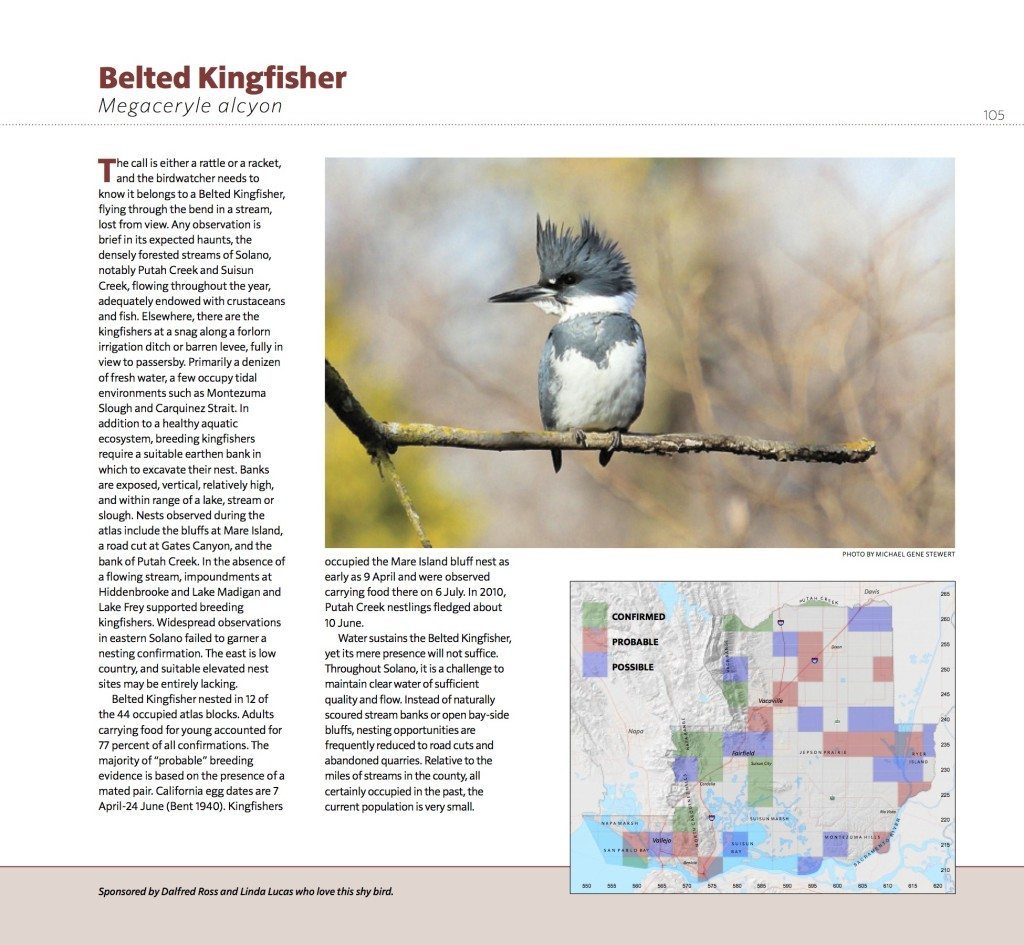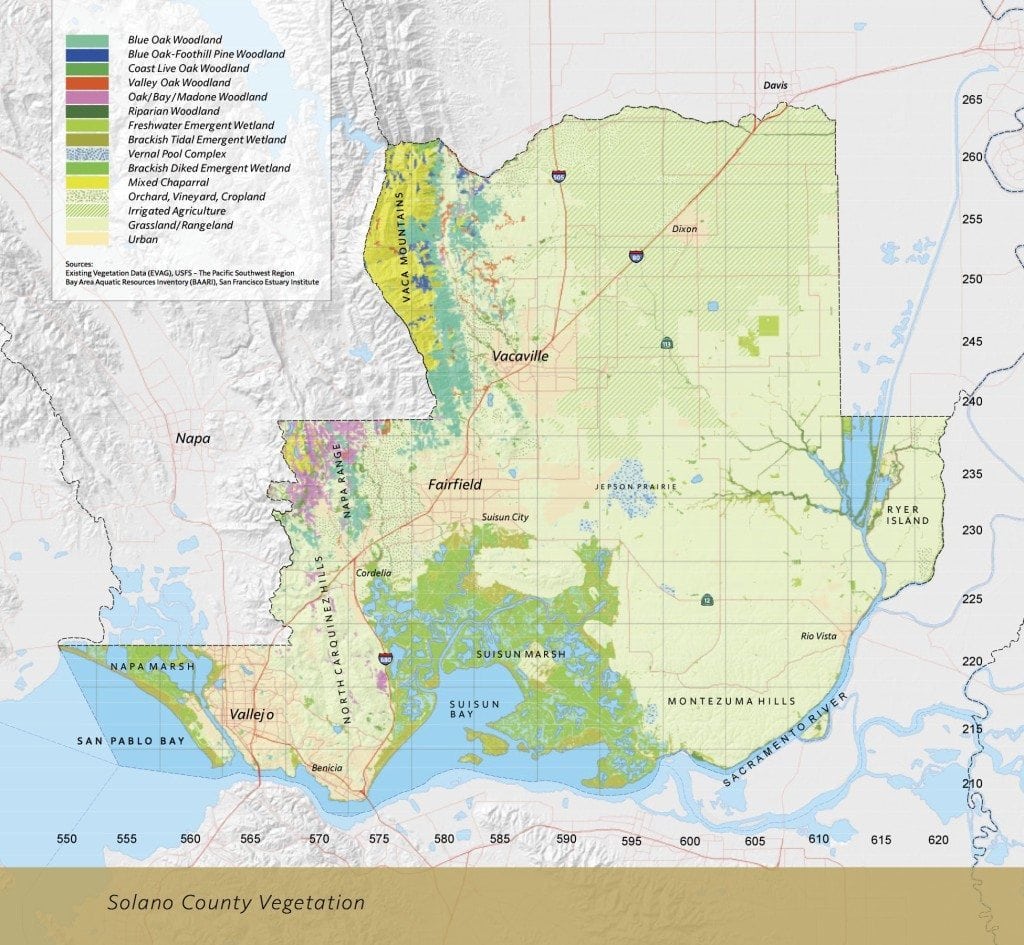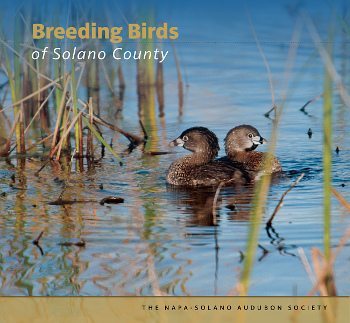A stunning bird atlas for Solano County
By Ilana DeBare
Breeding Birds of Solano County is a breeding bird atlas like no other breeding bird atlas you’ve ever seen.
With a glossy, photo-filled hardcover format and and a weight of over five pounds, it is as beautiful as any coffee-table art book produced by a museum.
Just published by Napa-Solano Audubon Society, the atlas would make a splendid holiday gift not just for birders but for anyone with an interest in California nature.
It provides descriptions of historic range, breeding behavior, and conservation status for 151 birds that nest in Solano County. It also offers 350 color photos by sixty Bay Area bird photographers, including 44 images by GGBA’s own board member and birding instructor Bob Lewis. And it has detailed color maps for each species, created by GGBA instructor and mapping professional Rusty Scalf.



If you’re not familiar with the concept of a bird atlas, the concept originated in Britain in the late 1960s — a systematic guide to birds that nest in a particular area.
The idea spread to the U.S. and Canada. On the East Coast, breeding bird atlases often cover an entire state. In California, they typically cover one county. The past 30 years have seen publication of atlases for Alameda (2011), Contra Costa (2009), Santa Clara, and Marin counties, among others.
The Solano atlas had its genesis a quarter of a century ago when birder Robin Leong approached Napa-Solano Audubon Society to create a volume covering Solano County. But the group could only raise enough funds for a Napa atlas. They did field work from 1989 through 1993, and finally published the Napa volume in 2003.
Solano then got its turn. Volunteers – including some GGBA members like Dave Quady and John Luther — conducted field surveys from 2005 through 2010. Organizers were determined to avoid another ten-year lag between field work and publication, and so in early 2013 ornithologist Murray Berner started writing the species descriptions and editor Mike Rippey started compiling photos.

Then came the logistics of publishing, which ultimately led to a printer in, of all places, Italy.
“People who will bind and make books in the U.S. are a dying breed,” Berner said. “The board didn’t want to go to China, and the U.S. was too expensive, and so Italy was kind of a middle ground.”
The Solano team followed the same fieldwork protocols as most other breeding bird atlases. They divided the county into nine-square-mile blocks and assigned volunteer birders to each block. The volunteers visited their designated area during nesting season — mostly April through early July — and looked for evidence of breeding birds.
They aimed for the highest of three levels of documentation — possible breeders (such as a male bird in appropriate habitat), probable breeders (such as a pair in appropriate habitat), or confirmed breeders (such as an adult bird carrying nesting material, or a nest with eggs, or visible fledglings).
Volunteers sampled each habitat type in an atlas block, spreading their visits throughout the breeding season for a more complete picture of the variety of species there. ‘The goal is to get the majority of your records confirmed,’ said Berner. ‘If you can get 50 percent confirmed, 35 percent probable, and 15 percent possible, it increases the validity of the data.’”
Among the surprising findings were eight or nine species that had never before been seen nesting in the county.
“We had Snowy Plovers and Least Terns at Montezuma Wetlands, a part of Grizzly Island Wildlife Area,” Berner said. “I was surprised to have Pileated Woodpeckers in the canyons of the Vaca Mountains. And we knew there were Common Gallinules around somewhere, but now we know they are on golf course ponds.”


There were also some discoveries that were less welcome. Through his research for the atlas, Berner realized how much of Solano County’s diverse farmland habitat had been transformed into tracts of single crops such as almonds and walnuts.
Similarly, much of its riparian habitat had been destroyed by farming and development over the past century. That meant the nearly complete loss of species like Yellow Warbler and Yellow-breasted Chat.
“Emerson Stoner recorded fledglings at upper Green Valley on 19 June 1937 and recorded three pairs in 1938,” the Atlas says on its Yellow Warbler page. “Fifty years later, surveys failed to find warblers there.”
“On an emotional level, it was kind of disappointing to see how things have evolved,” Berner said.
At the same time, working on the atlas provided participants with new and inspiring perspectives on familiar places.
“By doing the fieldwork, I went places I wouldn’t have gone – the Vaca Mountains, the Napa Range – which are still really wonderful,” Berner said. “Even if a park had been birded before, I saw it in a new light.”
While the glossy coffee-table format is the most obvious innovation of the Solano atlas, there were other ways in which it also set a new standard for breeding bird atlases.
There is an e-book version of the atlas, which offers the extra feature of audio files of bird calls.
Rusty Scalf’s maps are are far more detailed, numerous, and useful than maps in most other bird atlases.
And organizers helped fund the project by allowing people to sponsor a species page for $200. More than 100 donors stepped forward. So along with the well-researched descriptions and beautiful photos, many pages have a small, tastefully-designed note at the bottom that conveys the love felt by so many people for the birds of the Bay Area.
For Charlene James who loves yellow and being out in nature –John Glover (on the Western Meadowlark page)
The Black Rail: calls well known, sight unseen, anticipation –Sue Johnson (on the Black Rail page)
Its liquid gurgling ‘conk-va-reee’ always brings us family memories of learning bird songs. –Bob and Karen Martin (on the Red-winged Blackbird page)
—————————————-
You can order Breeding Birds of Solano County from the Napa-Solano Audubon web site. The hardcover costs $65, including tax and shipping. The e-book costs $30. You can order both versions together for $80.

